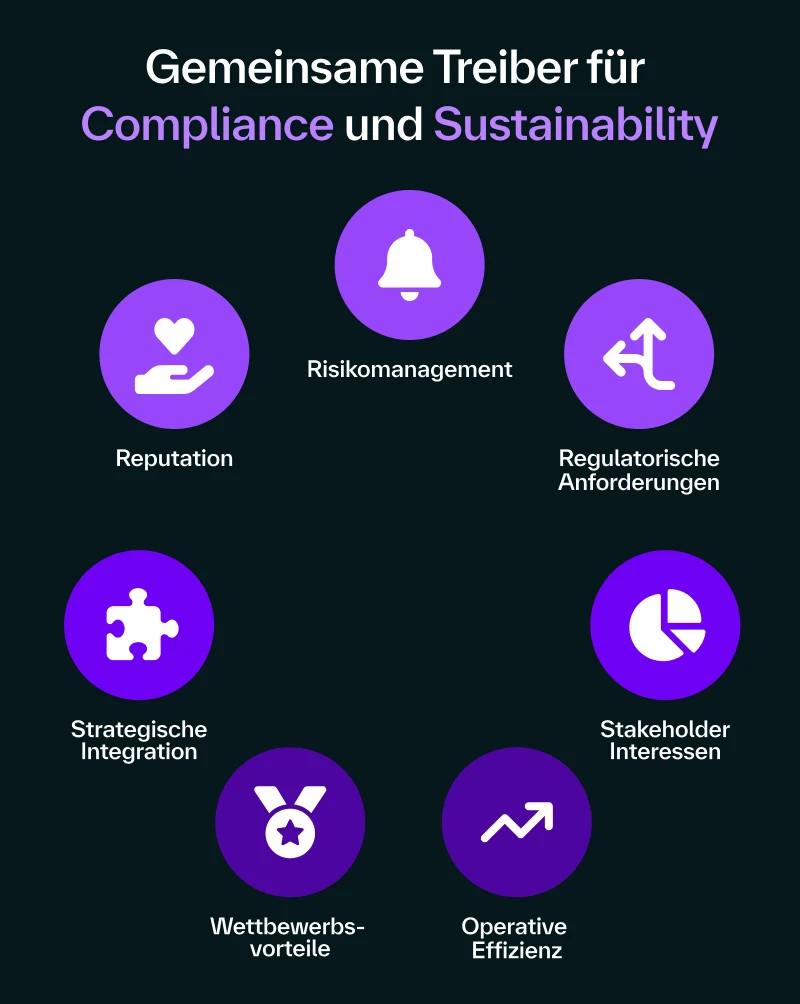Compliance and sustainability - two topics, one driver

Compliance violations can cost millions - as can sustainability deficits. What used to be separate corporate divisions are now growing together. Modern companies are recognizing this: Compliance and corporate sustainability are two sides of the same coin. Both aim to manage the company in a responsible and future-proof manner. Those who make use of these synergies reduce risks and create a sustainable competitive advantage. You can find out how best to achieve this in this article.
The most important facts in brief
- Strategic synergy: Compliance and sustainability pursue identical goals - responsible and future-proof corporate governance.
- Common drivers: Five factors characterize both areas: Reputation, risk management, regulatory requirements, stakeholder expectations and competitive advantage.
- Operational advantages: Integration of both areas reduces costs, avoids duplication of work and creates a holistic corporate approach.
- Employee role: Training and awareness-raising minimize risks due to unintentional misconduct.
- Safeguarding the future: Proactive measures in both areas create legal compliance and sustainable corporate success.
Why do compliance and sustainability belong together?
The days of isolated observation are over. Compliance has always ensured that companies adhere to legal requirements. Sustainability and consideration for the environment are rapidly evolving from a nice-to-have to a must-have - driven by economic benefits and stricter requirements such as the Supply Chain Sustainability Act (in german: Lieferkettensorgfaltspflichtengesetzt = LkSG) or stricter rules against greenwashing. Anyone who fails to comply risks high penalties and reputational damage, regardless of the size of the company.
Companies that take a close look at their environmental and sustainability strategy realize that compliance and sustainability are closely linked. Both areas pursue identical core objectives: They lead companies into the future in a responsible, ethical and legally compliant manner. At the same time, they help to minimize liability risks, whether by avoiding breaches of regulations, reducing environmental damage or protecting against lawsuits. This common focus creates scope for intelligent, integrated approaches.
Common drivers: seven factors that shape both areas
By pursuing a common goal, common drivers emerge:

Reputation: protecting the most valuable asset
A company's reputation is quickly damaged, but difficult to rebuild. Today, compliance and sustainability are central pillars of reputation management:
- Avoid loss of trust: Compliance violations or accusations of greenwashing can destroy trust that has been built up over many years in a very short space of time.
- Strengthen positive perception: Authentic environmental and sustainability efforts and transparent corporate governance create credibility.
Minimize media risks: Proactive measures in both areas reduce susceptibility to negative reporting.
Risk management: protection on several fronts
Integrated risk management protects against various threats simultaneously:
- Reputation protection: Compliance prevents greenwashing accusations and damage to image.
- Future-proofing: Proactive compliance prepares companies for upcoming regulatory requirements.
- Crisis resilience: Robust systems and processes improve crisis management.
- Minimize risks by building up knowledge: Further training of employees creates awareness of responsibility.
.png)
Regulatory requirements: The pressure is constantly increasing
Legislators are continuously tightening requirements - in both areas. While compliance regulations are already established, new requirements for sustainability are constantly emerging. This dynamic requires proactive action:
- Increasing legislative pressure: New laws to promote sustainability and transparency are emerging in rapid succession.
- CSRD & EU TaxonomyThe Corporate Sustainability Reporting Directive and the EU Taxonomy create binding standards for sustainability reporting and sustainable business activities.
- Movement in the regulatory environment: In addition to stricter requirements, there are also initiatives such as the EU omnibus legislative package, which aim to simplify existing regulations and make them more practicable for companies.
- National implementation: European requirements are gradually being transposed into national law.
Stakeholder expectations: Transparency becomes the standard
Modern stakeholders expect more than just figures, they demand responsibility and transparency:
- Customer demands: Consumers increasingly prefer responsible companies.
- Investors' wishes: ESG factors (environmental, social, governance) determine investment decisions.
- Publicpressure: media and NGOs are monitoring corporate activities more closely than ever.
Competitive advantages: Differentiation through responsibility
Companies that make strategic use of both areas gain measurable advantages:
- Market differentiation: Sustainability initiatives set you apart from the competition.
- Brand reputation: Compliance and sustainability strengthen the corporate image.
- Talent magnet: Responsible companies attract talent and promote employee engagement.
Operational efficiency: synergies create savings
The integration of both areas optimizes business processes and reduces costs:
- Resource efficiency: Sustainable practices increase efficiency.
- System integration: Joint compliance and sustainability approaches avoid duplication of work and reduce costs.
- Supply chain optimization: Integrated procurement processes increase efficiency.
Strategic integration: Holistic corporate approach
Successful companies anchor both areas in their DNA:
- Strategic anchoring: Compliance and sustainability become part of the corporate strategy.
- Product responsibility: Holistic approaches cover the entire product life cycle.
- Cultural change: Integration promotes a responsible corporate culture.
Understanding the differences: Compliance vs. Sustainability
Despite all the similarities, the two areas differ in important aspects:
There are long-established laws and guidelines for compliance, but also new regulations such as the EU AI Act, which can quickly lead to fines in the millions if breached. The first requirements for corporate sustainability have only been defined in recent years. The requirements at EU level have been and are being partially translatedinto national laws. As a result, there is a lot of movement in this area, with adopted directives being revised or discarded.
The role of employees in compliance and sustainability
All it takes is one careless click. A single click on a phishing link. A careless statement about sustainability goals. An overlooked detail in the recruiting process. Wherever people work, mistakes happen and they can be expensive. One of the biggest risk factors is therefore unintentional misconduct. The most effective way to avoid this? Creating knowledge and awareness.
every employee bears responsibility and must be aware of this. In both compliance and corporate sustainability, employees play a central role in ensuring legal certainty. Through training, awareness-raising and active participation, they help ensure that companies meet legal requirements and implement sustainable practices. A strong corporate culture that promotes integrity and a sense of responsibility is crucial to success.
Issues such as greenwashing, whistleblowing or competition violations can be avoided if employees are informed and aware of the legal pitfalls. In addition, sensitized and responsible employees make a significant contribution to ensuring that your company remains on the safe side and steers successfully into a sustainable and legally compliant future.
FAQ
What is the difference between compliance and sustainability?
Compliance focuses on adhering to legal regulations and internal guidelines in order to avoid legal violations. Sustainability promotes long-term economic, ecological and social business practices. While compliance primarily minimizes risks, sustainability also creates competitive advantages and future viability.
Why should companies consider compliance and sustainability together?
Both divisions pursue identical goals: responsible and future-proof corporate management. Integration avoids duplication of work, reduces costs and creates synergies. Joint approaches strengthen reputation, minimize risks and at the same time meet increasing stakeholder expectations.
Which laws and regulations are particularly relevant?
Established regulations such as the EU AI Act and the General Equal Treatment Act (AGG) are central to compliance. In terms of sustainability, the Corporate Sustainability Reporting Directive (CSRD) and the EU Taxonomy shape the requirements. These regulations are developing dynamically and require continuous adaptation.
You might also be interested in










